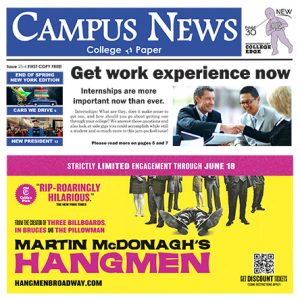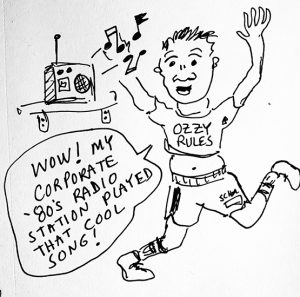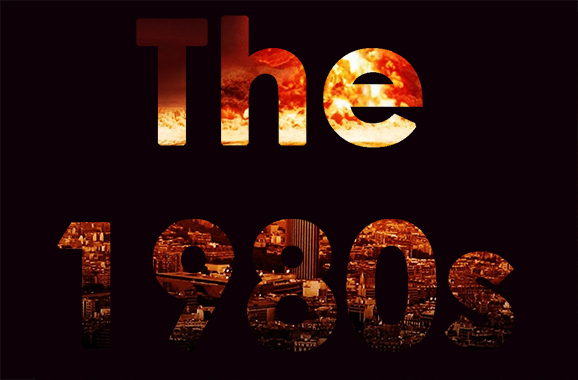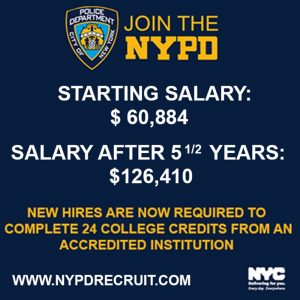By Darren Johnson
Campus News
When I was a kid, there was a wave of nostalgia for the 1950s. Movies like “Grease” and “American Graffiti” and the No. 1 TV show “Happy Days.” The simpler times, the exciting coming-of-age. Of course, the prosperity of that era was largely because the USA came out the big winner in the second World War; immigrants from earlier in the century had had kids who now were assimilated, new immigration was stalled and Blacks still hadn’t had the Civil Rights Movement that would come next decade.

I’m starting to see a similar wave of nostalgia now, but for the 1980s. The biggest hit since before Covid, “Top Gun Maverick,” is a nostalgic romp based on “Top Gun,” a movie that best defines mainstream big-machine entertainment of the 1980s. The biggest hit on Netflix is also set in the 1980s: “Stranger Things.” I guess it’s relatively easy for set designers to hit thrift stores to find forgotten dual-cassette boom boxes, parachute pants, ColecoVisions and the like.
Also, many of my students, if not most, are well aware of 1980s music and rather respect it. They consider it “modern,” as compared to Elvis or Motown. They buy the Talking Heads T-shirts. David Byrne has a hit Broadway show where he mostly sings Talking Heads songs. Also realize rap and hip hop really came about in the 1980s. I was an early adopter of the genre, playing Fat Boys and Slick Rick cassettes in my beat up Chevy Impala.
But let’s be real about the 1980s. While there wasn’t a real war – just a Cold War – the adventure of punk and New Wave to start the decade was corporatized and became Paula Abdul and Bobby Brown by the end of the decade. The “Top Gun” theme “Highway to the Danger Zone” is a typical tool tune, no different than Starship’s “We Built This City on Rock and Roll.” Horrible mall music, now played in the myriad casinos that have popped up.
Laws were changed and quirky media outlets, especially radio, were bought by national conglomerates. Local personalities were fired or at least their pay was cut while they were forced to toe the corporate line.
Colleges, which had been more casually administrated, started to bloat as President Ronald Reagan’s administration helped their banker backers, creating the whole student loan system that still weighs students down today. With easy money, colleges now could charge more – hire more administrators – and they became corporatized, as well.
My parents were able to buy a cheap house in the 1970s, but we were mostly cash-strapped in the 1980s. There were periods of high unemployment and high interest rates, as the rich and connected got richer. Does this sound like now?
Socially, things were better. It was perhaps the last era where kids were free to roam. Video game culture had begun, but it was more extroverted – pedal your banana seat bike to a local arcade, spend a quarter to play “Donkey Kong.” That was mostly a good thing.
As far as diversity, I experienced a lot of it, going to a school that had a wide variety of cultures. I see older photos, from, say the 1950s, of classes from that same school, and the classes were practically all white. By the 1980s, that same school had about the same mix of races as all of America. However, schools in the suburbs were still mostly white, like today. I guess they got to experience diversity when we’d play them in sports. Thankfully, many colleges are now much more diverse, so perhaps suburban kids can gain a wider perspective there.
Despite that the Cold War saw no real action, there was a huge military build-up in the 1980s. Again, friends of the Reagan administration got arms contracts. And while there was no draft, the military reported that movies like “Top Gun” were great for recruitment, and the wars were to come starting in the 1990s. I had a childhood friend who joined the military and was killed in Iraq.
While the 1980s were a decade of great transition, and the gritty beginning of the decade was smoothed out and sanitized by the end of the decade – much like Times Square – we went from fading department stores downtown to gaudy malls built on cheap swampland – not all of that change was for the better. Now those malls are falling into the swamps.
We are seeing rampant inflation now, but think about who is suffering, and who is profiting from that, and realize, like in the 1980s, the average person perhaps is just persisting, at the will of larger economic forces.
 Darren Johnson is publisher of Campus News. Its print edition is all over the New York Metro area. Help us out. Write editor@cccn.us.
Darren Johnson is publisher of Campus News. Its print edition is all over the New York Metro area. Help us out. Write editor@cccn.us.






Facebook Comments